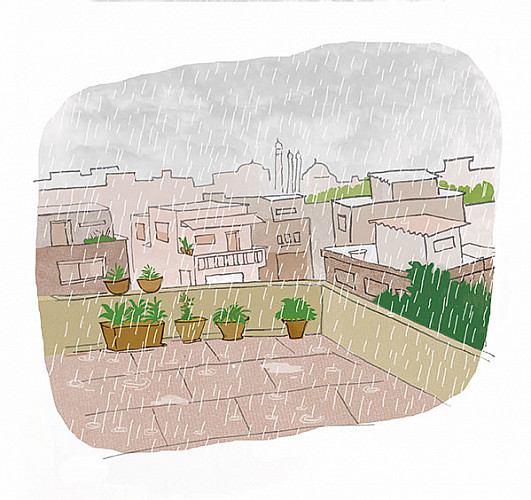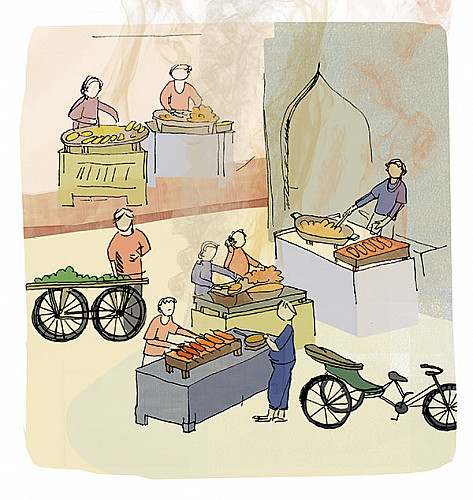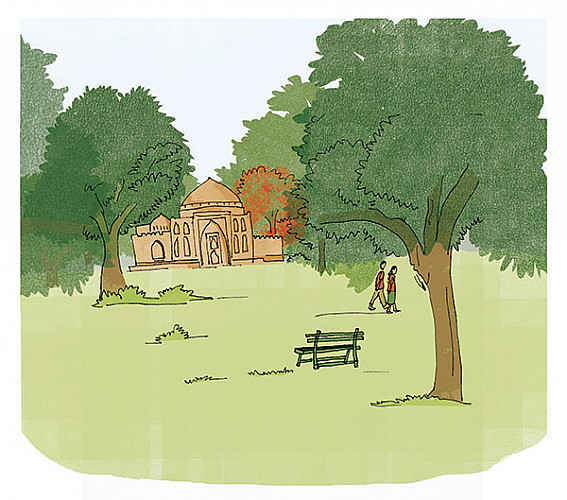Delhi’s Caprice In Climate And Young Love
Raging waters
I run up the stairs to the terrace of our bungalow in response to an ancient stirring. From across the tops of the Arjuna trees, I see the pregnant clouds gathering, heralding the first rain of the season. The arrival of the expectant clouds wakes the birds from their summer stupor. The diffident mynah calls to the bulbul, “When is the delivery date?” To which the bulbul, ignorant but loud, shrills, “Tomorrow. She needs to be fuller.” And then the peacock, midwife to every monsoon birth, cries out silencing them all, “Prepare yourselves, you fools. Here she comes.” Thunder and lightning together clap out the birth announcement and the earth wraps the new life in her blanketing embrace.
This is no half-hearted gentle rain of a civilised city; this is the passionate, torrential rain of the tropics. It awakens young lovers all over this ancient land; there is some magic, some nasha in these waters which lights new fires instead of putting them out. I run down and out onto the street to meet him. As I run, the monsoon bringing me to life, I can only think of Ghalib, that maddened Sufi who lived and loved in these Delhi monsoons: Mohabbat mein nahin hai farq jeene aur marne ka. Usi ko dekh kar jeete hain jis kaafir pe dum nikle. (In love there is no difference between life and death. The very one for whom I die, life too does bestow.)
“What do you know of love?” caution the elders. “Young love will die young.” Perhaps they are right. Perhaps they are wrong. But all I know is that I will never love this way again, drunk on the water of this mad first rain. Together, we bite into jamuns, each fruit like a tiny black cloudburst, making me run my tongue against
my teeth to get rid of the strange metallic feeling, electrifying and disturbing all at once. Sort of like love. Sort of like Delhi.
Mysterious mists
In some distant land, winter means snow. But Delhi is a law unto itself and here, winter means fire. It arrives with the fire of Dussehra and as the embers burn on Ravana’s many heads, the night turns bitterly cold. Dussehra’s smoke lives on for the rest of the season, intermingling with other ancient smoke. Muslim kebab wallahs cook their succulent meats in secret recipes handed down by the Persians — the smoke from their charcoal grills mixing with the shakarkandi ki chaat being roasted by the neighbouring Hindu chaat wallah. The smokes come together and in this heady mix lies the story of Delhi. Men from different religions decided to cook side-by-side and as the smoke from their cooking fires rose, so Delhi was born.
Winter in Delhi is marked by unending weddings, their havans another offering to the city’s smoke. I rouse myself from my razai — that cocoon of comfort in which a Delhiite can hibernate for months — and start to dress in the season’s best. Once at the wedding, I stand with him, our arms touching. Our bodies are far enough apart to not set gossip mills ablaze but close enough to make us burn, flushed in our own fires, unmindful of the winter frost. We have a long drive back together from this farmhouse wedding. I half wish that we would get lost in that winter fog, in Delhi’s ageless smoke.
Balmy perfection
Delhi is a like a gorgeous courtesan who drives her admirers mad with her tempestuous moods — in the summer she blows too hot, in the winter she is frigid — and all suitors must live with her eccentricities. For a brief period, though, somewhere at the end of February, she is placated and the weather is perfect. Balmy days dotted with bright sunshine lead to cool nights scented with the courtesan’s favourite, raat ki rani, the night-blooming jasmine.
Spring brings Delhi’s gardens alive. We walk around Lodi Garden together but we’re not calm. Young love is turbulent, and in this season of calm, we bring forth feverish arguments. We take rounds of that lovely garden and each one only adds to our endless circumlocutory quarrels. Aunties in their tight Juicy sweatsuits, as colourful as tropical birds, smile at us sympathetically — perhaps our misery is evident. We escape to one of the garden’s tombs and scratch our names onto the walls in a desperate attempt to immortalise our love. And, as if angered by our audacity, Delhi — that tempestuous one — immediately turns hot and fiery.
Searing suspense
Delhi’s white heat has eclipsed both man and monument. Every element has succumbed to her command. The birds are silent. The trees have stopped whispering their names. Nothing moves except a searing hot breeze from the deserts of Rajasthan, the Loo. The staff come running in to fasten the windows, but the fingers of this strange wind reach in until everything is covered in dust, inches thick.
I lazily move my hand to scribble my name in the dust. There is no other to lovingly write next to mine. I lie in my bed, watching the ceiling fan quarrel with the still air and think of my own quarrelsome nature always at its flushed worst in the summer. They say that the ruins of Indraprastha lie underneath this part of Lutyens’ Delhi. Ma always told me not to read the Mahabharata at home (“You’ll have a fight with someone you love.”) but she didn’t say anything about living in its combative neighbourhood.
There is nothing to do in this searing heat but to lie still and wait. Many others are waiting too. The maid wants to flirt with the neighbour’s driver; she’s worn a new nose ring today, but it’s too hot to walk to the cars. The driver wants to smoke his bidi but lighting another flame, however small, might make the whole universe go up in smoke. There is nothing to do but to lie still and wait for the rains to arrive.
Related posts from Verve:
Verve Trending
Sorry. No data so far.
us on Facebook to stay updated with the latest trends









